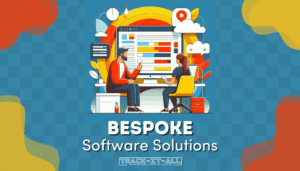The crux of organizational success within talent management resides in pivotal staffing strategies that align with business objectives. Effective staffing in talent management is not a static process but a comprehensive approach incorporating key components to attract, develop, and maintain a proficient workforce. This multi-dimensional strategy entails a meticulous understanding of talent identification, leveraging performance appraisals, and skills assessments to ensure each employee’s proficiencies are in symmetry with their respective roles.
Advancements in this field are marked by dynamic talent development programs, enriching employee skills with targeted coaching and robust training initiatives. Moreover, the essence of retention strategies lies in offering competitive remuneration packages, creating a positive workplace culture, and realizing career progression prospects which fundamentally boost morale and incentivize employee contributions. These integral practices build the framework of staffing in talent management, leading to increased productivity and substantial improvements in both worker tenure and an organization’s brand strength.
Key Takeaways
- Talent management integrates strategic staffing to meet business goals and improve overall productivity.
- Identifying talent aligns individual competencies with job roles, optimizing workforce efficiency.
- Developing talent through targeted initiatives enhances employee skills and organizational capabilities.
- Retention strategies are crucial for maintaining competitive edge and employee satisfaction.
- Key components of staffing in talent management contribute to a strong employer brand and sustained success.
Defining Staffing within the Realm of Talent Management
The landscape of talent management is continually evolving, as businesses strive to align their staffing initiatives with broader strategic goals. The core of this alignment lies in the implementation and ongoing execution of various staffing models, which collectively nourish the organization’s vitality and competitive edge.
Exploring the Continuous Nature of Staffing
In a thriving business environment, the continuous process of staffing forms the backbone of human resource efforts. This enduring cycle reflects the organization’s commitment to growth and adaptation, ensuring that personnel resources are ever-responsive to the fluctuating demands of the market and internal company dynamics. Such a process extends beyond mere hiring to encompass forecasting future needs, personal development, and strategic workforce planning.
Types of Staffing: Temp-to-Hire, Short-term, and Strategic Staffing
Temp-to-hire staffing represents a flexible approach, allowing companies to determine the suitability of a candidate for permanent employment through a temporary assignment. This model serves as a critical testing ground for both employee fit and performance. Simultaneously, short-term staffing addresses immediate operational needs without the commitment of long-term employment, offering agility to businesses facing seasonal spikes or project-based demands. The most forward-thinking approach, however, is strategic staffing in talent management, which aligns recruitment, selection, and employee development with the company’s long-range goals, including leadership succession and skill gaps bridging.
Integrating Staffing with Talent Management Processes
Seamlessly integrating staffing strategies within the broader talent management framework is pivotal for organizational harmony and efficiency. By doing so, companies are able to maintain immersion in a cycle of attracting, developing, and retaining talent that is continuously refined to meet existing and emergent business objectives. This holistic approach to staffing ensures that each role is filled with not just a competent individual but one whose career trajectory and aspirations align with the vision of the company.
What is staffing in talent management?
When we discuss what is staffing in talent management, we’re delving into the meticulous process of pinpointing and integrating the most suitable individuals into a company. This isn’t merely about filling vacancies; it’s a strategic approach centered on aligning employee skills with the organization’s objectives. Staffing in talent management spans across the exhaustive landscape of recruiting, assessing, and nurturing staff to elevate workplace performance and productivity.
Recruiting teams across South Africa and beyond are recognizing the benefits of effective staffing in talent management. These benefits often translate into a robust and well-prepared workforce that can propel the company toward its strategic goals. The implementation of thoughtful staffing strategies is widely considered a best practice for fostering an environment of continual growth and advancement. By ensuring that every new hire is not just a fit for the role but also for the company culture, effective staffing cultivates a workforce that is more engaged, motivated, and loyal. Additionally, remote monitoring solutions in South Africa are playing a key role in effective staffing by allowing companies to efficiently manage and support their workforce, regardless of their location. These solutions enable employers to keep track of productivity, communicate easily with remote employees, and provide necessary resources for success. By utilizing these tools, companies can ensure that their staff remains engaged and motivated, ultimately contributing to a more cohesive and productive work environment.
Here is a look at some of the key benefits that companies can expect from effective staffing:
- Alignment of individual competencies with business objectives, fortifying organizational success.
- Enhanced employee satisfaction and retention through suitable role placements.
- Streamlined hiring processes that save time and resources while attracting top talent.
- A cultivated reputation as an employer of choice, bolstering the company’s brand.
Moreover, the table below illustrates how businesses stand to gain from incorporating effective staffing practices into their talent management strategies:
| Aspect of Talent Management | Impact of Effective Staffing |
|---|---|
| Employee Retention | Higher engagement and reduced turnover due to improved job fit and satisfaction. |
| Work Quality | Enhanced output due to employees whose skills and interests align with their role. |
| Organizational Agility | Ability to adapt to market changes through a skilled, versatile workforce. |
| Innovation | Fostering a diverse team with varied perspectives to drive creativity and innovation. |
In essence, the union of what is staffing in talent management with the benefits of effective staffing culminates in a powerhouse of organizational potential. It’s a synergy that not only meets the immediate staffing needs but fosters a sustainable, productive environment for the company’s future.
Staffing Processes in Talent Management and Their Impact
The seamless integration of staffing processes in talent management is pivotal to nurturing a robust workforce that drives organizational success. These processes encompass a multitude of strategic activities, each contributing to the effective deployment and growth of human resources within a corporate landscape. Below, we delve into the key phases that underpin staffing processes, exploring their singular and cumulative impact on employee integration, career progression, and the broader organizational vision.
The Recruitment Spectrum: From Job Analysis to Selection
The commencement of staffing processes in talent management traditionally begins with meticulous job analysis and manpower planning. This foundational step ensures that recruitment efforts are precise and tailored, addressing the specific needs and complexities of each role within the organization. As the spectrum progresses, sourcing candidates and screening them against essential competencies become the focus, culminating in a rigorous selection process that filters the best fits for the company’s strategic goals.
Orientation and Placement: Ensuring Effective Onboarding
Upon successful selection, effective onboarding takes precedence as a critical channel through which new hires are integrated into the organizational fabric. This phase is about more than just orientation; it’s about establishing a profound connection between the employees and the company’s culture, values, and operational ethos. The quintessence of effective onboarding is in facilitating a smooth transition that not only imbues new staff with requisite knowledge and tools but also solidifies their role placement within the tapestry of the organization’s workforce.
Employee Growth: The Roles of Training, Appraisal, and Promotion
Employee career development is a cornerstone of talent management and is profoundly influenced by training programs, performance evaluations, and appraisal systems. These elements serve as conduits for career progression, enabling employees to hone their abilities and ascend through the organization’s ranks. Promotions and role transfers are often the fruits of these processes, signifying a workforce that is ever-evolving and commensurate with the organization’s aspirations.
| Staffing Stage | Objective | Impact on Talent Management |
|---|---|---|
| Job Analysis & Planning | Define role-specific competencies and company needs | Precise alignment of hiring efforts with strategic requirements |
| Recruitment & Selection | Identify and select candidates with optimal skill sets | Enhanced quality of new hires and alignment with company culture |
| Onboarding & Orientation | Integrate new employees into the organizational environment | Reduced turnover and accelerated productivity |
| Training & Development | Invest in employee skill enhancement and career progression | Long-term employee retention and creation of a leadership pipeline |

Collectively, staffing processes in talent management bear significant implications not just for individual employees but for the entity as a whole. The strategic intertwining of these processes assures the cultivation of a capable and committed workforce, inherently aligned with the organization’s strategic direction and prepared to tackle the dynamic challenges of the modern corporate arena.
Breaking Down the Importance of Staffing in Talent Management
Understanding the importance of staffing in talent management is vital for any company aiming to achieve robust growth and lasting market presence. Sound staffing strategies ensure that a business doesn’t just fill positions for the sake of it but identifies and nurtures individuals who can genuinely add value to the organization’s operations and culture.

An organization’s success through staffing comes from a clear alignment between an employee’s personal career goals and the strategic direction of the business. It is the joint force of individual talent and collective vision that turns performance metrics into real-world achievements. Staffing is more than just a recruitment function; it is a strategic imperative that underpins every facet of talent management.
- Staffing ensures the right individuals are in the right roles, improving productivity and job satisfaction.
- Through careful selection, staffing mitigates the risk of turnover, therefore saving costs associated with hiring and training.
- A strategic staffing approach integrates future planning, readying the organization for market changes and technological advancements.
- It fosters an adaptable workforce, primed for both the challenges and opportunities presented in dynamic business environments.
Whether it’s the precision of matching candidates to roles or projecting future competencies requirements, the emphasis on staffing in talent management is a narrative of synergy and foresight. Thus, tapping into the full potential of staffing is synonymous with unlocking the growth narrative of the modern enterprise.
How Staffing Strategies Influence Organizational Success
Organizational success is deeply rooted in the effectiveness of staffing strategies in talent management. It’s a holistic approach that encompasses not just hiring but the foresight and planning that preempts market trends, leveraging an agile and adept workforce. Rigorous staffing policies can be the difference in not only attracting exceptional talent but retaining valuable employees, thus overcoming staffing challenges across all fronts.
Innovative Approaches to Overcome Common Staffing Challenges
In a rapidly evolving corporate world, overcoming staffing challenges demands more than conventional methodologies. A blend of innovation and data-driven insights paves the way for staffing strategies that surmount the intricacies of talent acquisition and management. Adapting to these changes swiftly is paramount for businesses ambitious in securing a competitive edge and ensuring their staffing strategies contribute constructively to their talent management ecosystem.
Building and Sustaining a Strong Employer Brand through Staffing
The power of employer branding in today’s job market cannot be understated. It’s not just about the message organizations send out to prospective employees but also about the lived experiences of current staff. Through strategic staffing, companies can craft and promote a positive image that resonates with both current and potential talents, fostering an environment that attracts and retains the best in the field.
Staffing Analytics and Forecasting as Strategic Tools
Staffing analytics and forecasting emerge as frontrunners in the toolkit of modern staffing strategies. With a wealth of data at their disposal, companies now have the unprecedented capability to analyze trends, predict staffing needs, and proactively adapt to the changing demands of the talent market. This forward-thinking approach ensures that organizations are not only prepared for the staffing challenges of today but are also equipped for the workforce demographics of tomorrow.
Conclusion
In the realm of talent management, the ethos of effective staffing cannot be overstated. It emerges as a linchpin in galvanizing the entirety of talent management processes, catalyzing organizations onto a trajectory of substantial growth and achievement. Effective staffing serves as the blueprint through which companies can surmount their human resource challenges, employing a blend of foresight, adaptability, and strategic innovation. With a deep-rooted commitment to evolving the workforce’s abilities, organizations position themselves as vanguards of not just meeting, but also exceeding their articulated business aims.
Strategic staffing methods stand as testaments to an organization’s dedication to its core asset—its people—and to the sustainability of its success. By integrating effective staffing into the fabric of their talent management strategies, companies across South Africa empower themselves to craft a durable talent pipeline. This is one that not only fills vacancies but thrives by continuously nurturing skill, fostering leadership, and embracing the diverse potential within their ranks. Such strategies underscore the pivotal role that talent plays in fostering organizational achievement and the broader economic landscape.
It is clear that when companies embed effective staffing within their talent management framework, they not only lay the groundwork for operational excellence but also affirm their resolve towards long-term organizational success. Ultimately, staffing is not just about recruitment; it is about building a catalyst for enduring achievement within the ever-dynamic business environment. As businesses harness these staffing strategies, they pave the way for a resilient, innovative, and performance-driven culture, setting the stage for exceptional organizational landmarks in the ever-evolving world of work.







